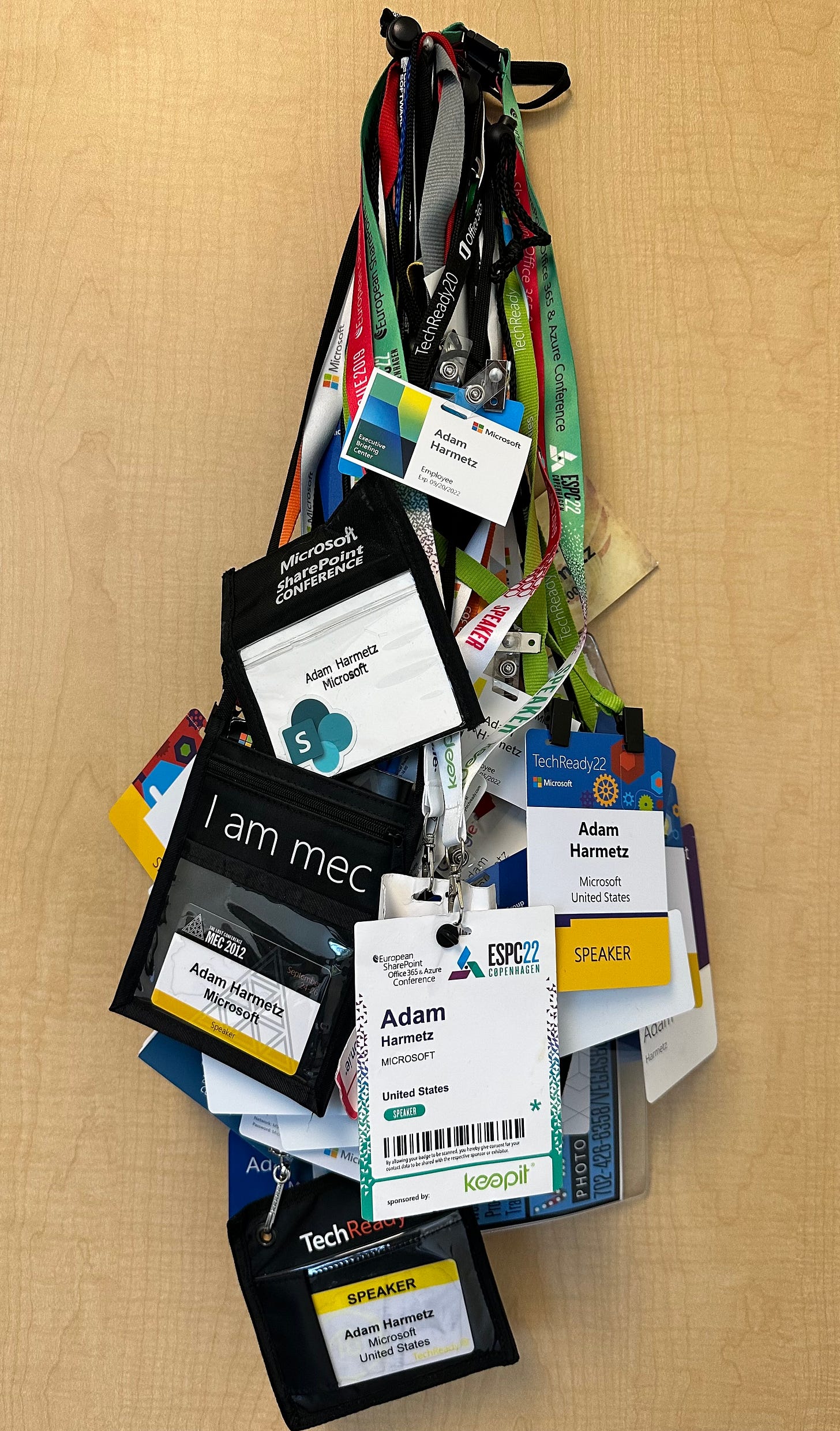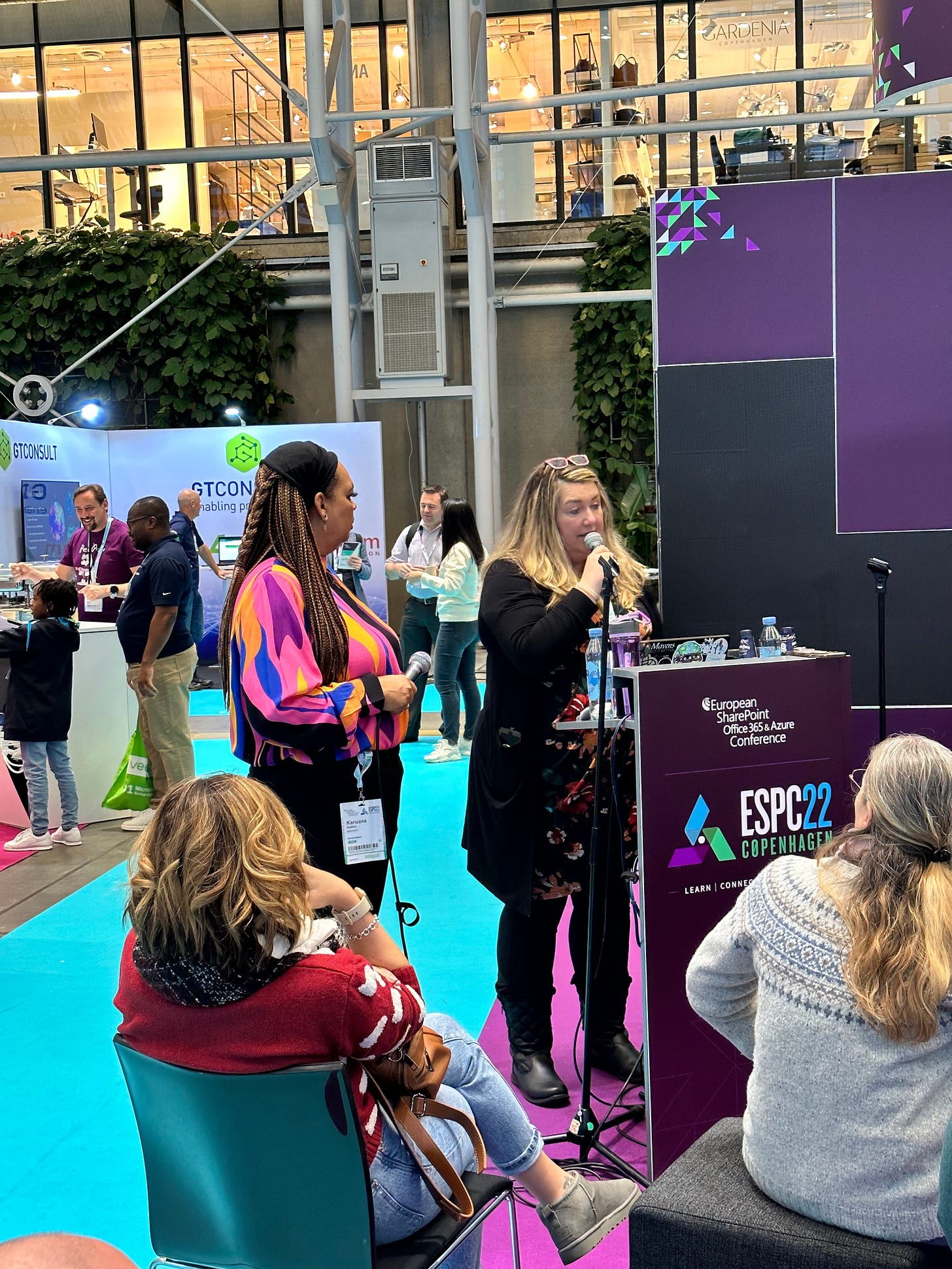🧳Sharing the Point of Tech Conferences (Redux)
How connecting with the ecosystem and community gives me purpose as a product maker
Happy Thanksgiving! 🍂 Adam here! With Microsoft Ignite a couple of weeks ago and the upcoming ESPC conference again this year, tech conferences are back in my life! For this week’s post, I wanted to reprint from last year the essay where I framed the what and why of tech conferences. Enjoy!
I’ve been to over 50 tech conferences in my 18 years as a product manager in enterprise technology. It was a part of the routine and defined the seasons of our team until the pandemic started and a three-year hiatus began.
In November 2022, it was time to return to the circuit! I had the privilege of attending ESPC22 in Copenhagen, Denmark - a 1,800-person conference dedicated to all things SharePoint, Teams, Viva, and Microsoft 365. So I got back into my old travel habits: polishing the PowerPoint decks, packing the bags, and giving a multitude of thanks to Helen for holding down the household. I even got a super cool shot of the Northern Lights on my Iceland Air flight over the Atlantic:
A three-year break gave me perspective on the “Why?” of this business travel. After I removed the hassle of traveling, the stress of leaving family behind, and the grueling routines of conference food and time zones changes, I’m left with a week that grounds me as a product builder and connects me back to my purpose at work.
It strikes me that there are a lot of new people in the tech industry who haven’t had a chance to experience an event like this - so this post attempts to capture what it’s like and why it’s important. Here are a set of “moments that mattered” during my week of work travel that helped me refine the meaning of my team’s work.
Moments that Matter #1: Walking the Showroom Floor
If you’ve heard me talk about my purpose at work, you know that nurturing a vibrant economic ecosystem is a core way that I believe my team contributes to the well-being of others and hence our purpose. Thousands if not tens of thousands of people feed their families because of the jobs and business opportunities we create with our work. As Bill Gates always liked to say, “You are only a platform if your partners make more money than you.” (At our last survey, the SharePoint ecosystem generates 4x the revenue that Microsoft accrues and is a over $10B/yr ecosystem).
One of my favorite meaningful moments is to soak in the showroom floor at a conference and examine the different types of vendors:
One of the signs of a healthy ecosystem is how diverse the partner ecosystem is. Pretty much every product has partners who extend on security & backup dimensions (everyone pays for locks!) – and ESPC has many of those vendors. It also featured employee experience vendors, intranet-in-a-box companies, BI solutions, solution integrators, administrative simplifiers, content management solutions, and toolkit vendors for IT/LOB teams. It’s dynamic, too, with Staffbase buying Valo Intranets and AvePoint buying TyGraph recently. I always use these conferences for a check-in on the ecosystem, how my company and team are helping (or how we could do better), and to just soak in the opportunity we create.
Moments that Matter #2: Nurturing Our Super Fans
Here I was on stage in front of 1,800 people, demoing the brand-new Calendar view of Microsoft Lists:

It was an applause line moment and the crowd delivered. It’s a pretty amazing gift if you think about it. How many people ever get this much interest and recognition from their work? I certainly never envisioned this goal state when I started coding my Hello World apps in CS101 back in college. Wow.
But it’s more impactful than just recognition (although that’s really nice too). Appreciation from super fans gives you a perspective on what’s important as product makers in a way that no amount of usage graph charts can (although to be clear, great product making requires both!). It helps you build intuition towards delighter features – things that motivate an emotional connection with the software we create.
It also humanizes our work. Here’s another moment that mattered in the Super Fan category: I got a chance to meet with the Viva Explorers, an emerging band of community members who are out there evangelizing Viva, one of our new product suites. Hats, stickers, pins, and Viva nail polish (!!):
What a great crew of folks to have in mind as I think about who is on the other end of the line as we make product decisions. A passionate crew of Super Fans that show up to places like this in unique ways to express their love for my products is a gift – and a responsibility to deliver for them.
Moments that Matter #3: My Role as a Sponsor and Reminders to Prioritize Guidance and How-To’s
On Wednesday, I was giving a podcast interview for someone who runs a local community group in Oslo. He shared with me how 8 years ago he took a picture with Jeff Teper, our org’s President, and his newborn baby and posted to Twitter as “the newest member of our community.” Since then, he’s tried to take a picture with Jeff and his son every time they meet up. He reflected to me how awesome it was that every time they see each other now, Jeff proactively asks how his son is doing. He said that these simple acts make him feel connected to something larger.
When I go to a conference like this, I’m not only showing up as Adam the human but also Adam the representative of Microsoft, the company at the center of this ecosystem. It’s got a feel that is something akin to a mid-sized-city official showing up to the town fair. I have a role to sponsor and connect with folks. It’s a chance to practice curiosity and empathy. This is an important way that we humanize Big Tech.
It goes beyond just the figurehead role that we play as employees when we show up to conferences about our products. The work we do creates implicit sponsorship for people's careers. Our work creates opportunities for growth and helps people practice mastery. Attending conferences reminds us of this - and in particular, it reminds us how great PM feel ownership of the entire product lifecycle, including guidance, How-To’s, and making ramping up on the product accessible and rewarding. Here are two stories that exemplify this.
“My first time giving a talk.”
“Oh hey, you’re Adam, aren’t you? You know all about Viva, right? I’ve really been wanting to meet you.”
Just as the elevator was about to close, I heard those words. I stepped out and met Anoop, a new community member and contributor to our open-source toolkits. He was speaking for the very first time at a conference – his inaugural talk was on how to create Viva Connections dashboard cards. He was nervous about the talk, as anyone would be, but very glad he pushed himself to give back to the community in new ways.
It was so cool to see someone use our very latest dev models to push their career and skillset and grow into speaking roles. I find such purpose in providing an ecosystem that enables folks to thrive and grow.
“I grew up with SPFx.”
At a lively feedback session on our dev model from the team, which we codename SPFx, I got to hear the origin story of someone who started using SPFx 1.07 as an intern in college and is now a full-time developer and giving some of the best feedback on SPFx 1.16. Here's someone who has marked their careers by my team’s release date.
I collect and share these simple stories with my team to remind them how important it is to provide guidance and empower developers and operators with our work. It's helping someone thrive in their career.
Moments that Matter #4: Exporting our Microsoft Culture
“You Helped Me Feel Six Months Ahead”
Earlier this year, I talked with a community member who works in IT about what product management is and how the profession is evolving. I gave him a download of how we do it at Microsoft and a few book recommendations. He stopped me at the conference this week to thank me. His org is shifting and adopting new product management processes now and he feels way ahead of the game in predicting what’s coming.
I find that people are curious about the way Microsoft works and how we apply a Growth Mindset. We have a point of view on the way big tech should navigate the next decade of social impact from our work – a view of leadership rooted in vulnerability, allyship, and empathy.
To that end, conferences like these are a chance for us to talk openly about how we approach leadership, diversity, and inclusion. Karuana and Heather are two colleagues of mine who rocked this with a fantastic back-and-forth casual best practice session on applying inclusive leadership as part of the conference’s D&I track. Scott Hanselman also gave one of the 4 keynotes for the conference and it was all about inclusion and gatekeeping in tech.




Moments that Matter #5: Helping Customers On the Journey, Not Just Building the Destination
“What does your company do?” “Oh, a lot of migration and initial adoption assistance”
Such was the start of my lunch conversation on Tuesday with a booth vendor who shared a table with me. This is a common conversation throughout the conference - customers need to know not just what’s cool about the new tech, but are looking for partners on the journey to get there.
Conferences are a checksum on our bias for the unmitigated disruption that can be the default style of tech teams as they quest to innovate. Few customers are starting from scratch and great feature design takes that into account.
There were many other micro-moments from the conference that reinforced this need for my team to be partners with our customers on adoption, modernization, and migration. Our product leader Ask Me Anythings are always great reminders on the dependency customers have on our full surface area, as are 1:1 conversations with key IT leaders where often the on-premises implementation of our product from 2010 is in the equation. I use conferences to reground me in this need to be journey-makers, not end-point deliverers.
Moments that Matter #6: Zeitgeist of Product Adoption
And yes, of course, these conferences are a great chance to be curious about customer stories, feedback, and how’s adoption going. I leave with reams of scribbles on product ideas and suggestions that generate weeks of notes and inputs to the team.
I break down all this product feedback into multiple different categories:
Use Cases. I’m always on the hunt for cool use cases, especially unexpected ones or ones that use multiple parts of our product together in novel ways.
Feature Requests. Drink every time a Microsoftie says “That’s good feedback” is a common refrain. Of course, we can’t commit in real-time and we also prefer people use our scaled feedback channels to vote up/down community suggestions, but nonetheless tracking new backlog items is an important part of the pattern matching a product manager does at a tech conference.
Roadmap & guidance confusion. Hearing what customers ask questions about that I thought we were being clear on is one of the best gifts of the conference. I always walk back with several examples of “oh, we could have been clearer about this” or “the community isn’t understanding our POV yet on that.”
However, the most important takeaway I get from a conference like this is that it’s a chance to leave the Redmond bubble and synthesize the big picture of a product’s adoption curve. What are the biggest issues? What is hunting? What's the "feel" of a product among its fans, adopters, and implementors? The fact is a lot of conference product synthesis can be rife with confirmation bias, so individual feature requests are hard to get a great signal on. But part of my job is to be a journalist and level up - thinking about the entire week’s interactions holistically to form a 2-5 sentence “zeitgeist” of a product state. If you work at Microsoft, you can check out my Viva Engage Storyline to see my zeitgeist write-up from ESPC for SharePoint & Viva products.
Wrapping Up
I hope this post is helpful for anyone who is journeying to their first tech conference as a product manager and wants to know what to look out for.
I’d be remiss if I didn’t conclude with one final piece of awesomeness from conferences: connecting with people. Yes, I’m an introvert too and this much social interaction can be draining. Yet when I pushed myself beyond the defaults of my personality, there was a lot to savor. I got to be an observer as many members of our community reunited for the first time in three years. I got to see folks on my team who were hired from the community be in their element as community leaders now. I got to connect with colleagues in a less hectic setting - some of my favorite moments were breakfasts that turned into 2-hour sessions about career, life, and product. Ironic at times, but we spend more quality time with team members at these conferences sometimes than we find in the day-to-day of the office itself. Enjoy them!
For More Info
If you liked this post for its value in helping you find the deeper meaning behind your work, check out two other writings in a similar vein:
Thanks for reading and sharing Mind The Beet!







